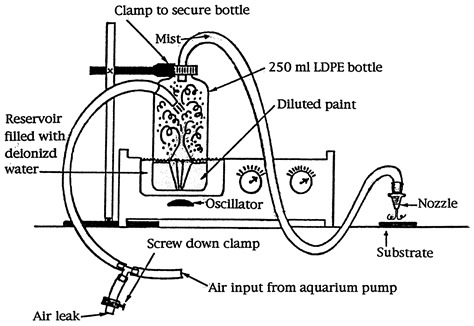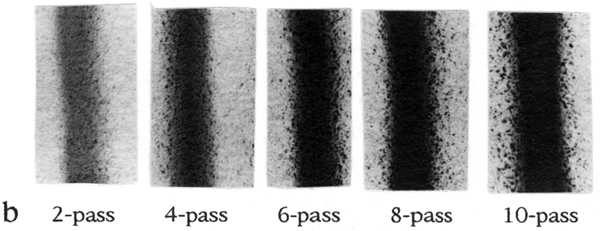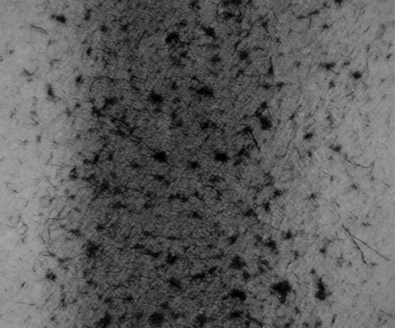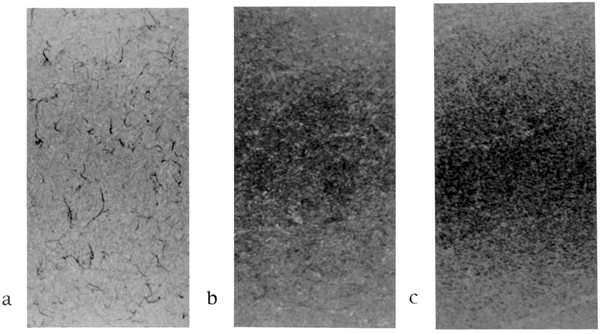January 2001 Volume 23 Number 1
![]()
![]()
January 2001 Volume 23 Number 1
Ultrasonic misting has been used in art conservation for more than a decade in applications involving consolidation, humidification, and stain removal, but possibilities of misting paint as a technique for inpainting problematic matte surfaces have yet to receive serious scientific investigation. At Queen's University, where I completed a Master of Art Conservation degree this fall, I carried out an experiment to study the viability of developing an ultrasonic misting system for the delivery of paint to a substrate.
Because ultrasonic misting allows small amounts of dilute solutions to be applied to objects under low pressure, it has been found to be particularly useful in the consolidation of powdery pigments and other thin layers on various types of art works and artifacts (Michalski and Dignard, 1993; Michalski, Dignard, van Handel, and Arnold, 1994; Michalski and Dignard, 1997; Dignard, Douglas, Guild, Maheux, and McWilliams, 1997). By the same principal, a fine paint film may be built up in controlled increments, avoiding saturation and unwanted gloss. The following discussion summarizes my experimental method, most significant results, and conclusions.
The method devised for ultrasonic misting by Stefan Michalski, Carole Dignard, and others at the Canadian Conservation Institute was followed with slight modifications.
The water tank and atomizing chamber of a household Mastercraft "Super" ultrasonic humidifier were removed. A 250 ml LDPE (low-density polyethylene) "Boston" design (Nalgene squeegee) bottle was placed just above the ceramic piezoelectric transducer (oscillator) at the bottom of the unit's reservoir and firmly secured with a clamp attached to a laboratory stand.

A "Maxima" aquarium pump was connected to the bottle with a 1 m section of Fisherbrand clear PCB tubing with an inner diameter of 8 mm (5/16") and outer diameter of 11.2 mm (7/16"). A second 1.5 m section of tubing was used to deliver the mist. It was attached to the outer section of a HDPE quick disconnect connector (outer diameter: 6-8 mm), which functioned as a round nozzle. Using a quick disconnect connector, instead of a two-sided reducer-connector, eliminated the need for chromatography paper to be placed as a blotter inside the nozzle; the quick disconnect connector provided an even join with the tubing and drainage of condensed moisture from the nozzle was not a problem.
The mid-section of the output tubing was also kept lower than the nozzle to prevent any drainage of condensation from the tube. In addition, the inner section of the same two-part quick disconnect was modified by cutting down the larger end to fit inside the tubing and used to connect the 1 m section of tubing to the aquarium pump.
The reservoir was filled with deionized water (at room temperature) until the float switch rose to its highest position. The bottle was filled with from 10 to 45 ml of paint diluted with deionized water. This put the paint level in the bottle either even with or lower than the water level in the reservoir. The bottle required small adjustments in its position, while it continued to rest on the bottom of the reservoir, to be correctly aligned with the transducer.
The volume of the mist production was controlled with the humidistat and mist volume control knobs on the side of the humidifier. A mist could be generated at different settings from approximately one-third to maximum on each. At these settings, ultrasonic vibrations from the transducer overcame the surface tension of the dilute paint, causing the paint to erupt and form a conical jet that rose nearly to the top of the bottle. The mist appeared to emerge from the surface of the conical jet.
The aquarium pump provided a source of compressed air that entered the bottle at low pressure and forced any airborne paint droplets through the output tubing to the nozzle. A screw down hose clamp on an air leak attached to the air intake tubing allowed the quantity and velocity of the mist to be altered. It was kept in a closed position for consistency and optimum air flow.
Four types of copper phthalocyanine blue, water-based paints were selected for the experiment: Dr. Martin's "Hydrus" liquid watercolor, Da Vinci tube watercolor, Cotman pan watercolor, and Golden airbrush acrylic. The chemical composition of the pigments in the four paints was verified by infrared spectroscopy.
Paint film samples were produced by placing a piece of "University Products of Canada" conservation quality acid-free blotting paper (buffered with 3% calcium carbonate) horizontally on a flat surface next to the ultrasonic mister and passing the mister's nozzle slowly across the substrate as the nozzle emitted a jet of mist. The nozzle was held vertically approximately 0.5 cm above the substrate and moved in a straight line to produce a paint sample with an area of approximately 1 cm by 4 to 5 cm. The nozzle was moved slowly but continuously without allowing the misted solution to saturate an area. Instead the color intensity was controlled through the application of repeated passes.
It was determined that all of the four water-based phthalos misted readily as long as the paint was sufficiently dilute. Tests were conducted to find the maximum mistable concentration of paint to solvent. A measured amount of paint was added to a measured volume of water and a misted sample was produced as described above. More paint was added to the solution incrementally, with samples made at each increase, until the mist ceased. In the case of the two liquid paints, tests were also run at the full strength provided by the manufacturer. The four paints were tested three times each on separate occasions to demonstrate repeatability.
The maximum mistable concentration of paint to water was not observed for the Dr. Martin's liquid watercolor, since it continued to mist up to the manufacturer's full strength. The Golden acrylic paint, although ready for spraying in an airbrush at full strength, did not mist beyond about 63% paint to water. The Da Vinci tube watercolor stopped misting at about 28% paint to water and the Cotman pan watercolor stopped at about 22% paint to water.
These percentages cannot be compared, however, since the amount of water referred to is only that which was added to paints that already contained varying amounts of water, from the solid pan paint to the semi-liquid tube paint to the two fully liquid paints. To determine the total amount of water in each paint would require all the components of the paint, including the pigment, medium, and any humectants, plasticizers or other additives, to be isolated and measured. What the experiment did make clear was that viscosity was an essential factor in misting paint; it was only when the viscosity of the four tested paints exceeded a certain level that the paint failed to mist.
Further tests were undertaken to explore the visual effects produced in the paint samples. From two to forty or more passes were made with either a continuous back and forth motion or a one-minute pause between each pass to promote better absorption by the substrate. Humidistat and mist volume control settings were also varied. Increases in the intensity of color were proportionate to the number of passes, as would be expected, but the intensity differed considerably from one paint to another so that, for instance, it took twenty passes of the Golden airbrush paint (60% paint to water) to reach an intensity level equivalent to that of two passes of Dr. Martin's liquid watercolor at full strength.


At the same time, none of the paint films produced as samples up to this point were of sufficient evenness to be reliable for inpainting. In addition to slight variations in thickness due to the unstable, low-pressure air flow of the mister, a type of irregularity that was particularly noticeable consisted of small specks of dark paint scattered across the samples, an effect that shall be referred to here as speckling.

Since the paint build-up thinned at the edges of a misted area, the speckles were more conspicuous around the edges where the white of the paper showed through, although the speckling in fact continued across the whole area of color (Figures 2 and 3). The speckles were smaller and lighter, however, with the Golden acrylic airbrush color than with any of the three watercolors. Even in samples of up to two hundred passes, the speckling was less marked in the acrylic paint in comparison to samples of twenty passes of Dr. Martin's watercolor. The samples were examined with a Nikon stereobinocular microscope (photomicrographs of selected examples were made with a Canon A-1 camera coupled to a Carl Zeiss Jena Opmi II surgical microscope with a magnification of 16X).
Under a magnification of 10X, the speckles could be separated into two distinct types of spots that might be called spatters and agglomerates. Spatters were generally larger (up to approximately 1 mm in diameter) and looked like splashes of dilute paint that had spread laterally somewhat as they were absorbed into the blotting paper. They were darker than the predominant tone of the sample, especially in thicker paint films.
The agglomerates were smaller, darker spots that existed where the ends of some of the cellulose fibers of the blotting paper were bent up away from its interlaced body of fibers and these stray fibers were covered with tiny globs of paint. Samples of the three watercolors all displayed both spatters and agglomerates, but the Golden acrylic color was free of spatters, accounting for the less discernible speckling in the latter consisting of agglomerates alone (a). Samples were also prepared using two new kinds of substrate:
The mist was applied in continuous passes across pieces of the blotting paper, Brystol plate, and gessoed panel placed side by side. The results on the Brystol plate and the gessoed panels with all four paints contained neither spatters nor agglomerates (b and c).

Instead, however, the paint films produced on Brystol plate were composed of tiny droplets, not all of which were absorbed by the smooth paper and some of which remained on the surface. While nearly indiscernible at the start, with repeated passes the droplets built up more and more and then pooled, finally (after eight passes of full strength Dr. Martin's, for example) becoming evident without magnification. In the case of the gessoed panels, no pooling took place. The paint arrived at the surface as droplets but was sufficiently absorbed by the substrate for a number of passes. With the full strength Dr. Martin's, the surface began to acquire a slight gloss after eight passes, indicating that it was about to become saturated. Thus, the most even, misted paint films, free of spatters, agglomerates, and pooling -- although still displaying slight variations in thickness -- were those produced on gessoed panels.
Samples were also made using a Paasche airbrush (double action internal mix with single button control) on the three substrates. The resultant paint films were even, with none of the surface irregularities (except pooling on the Brystol plate) described above.
The uneven textures found when paints were applied with an ultrasonic mister on three types of substrate did not occur with an airbrush, however, airbrushes require a pressure of at least 20 psi, while misters function with a pressure at a tenth of that -- and the more gentle air flow had some advantages. The mister was easier to control, could be manipulated with little skill, and clogging in the nozzle was not a concern. This allowed a wider range of paints with higher viscosity to be used. Although the experiment was limited to only four paints and one color, the ease with which these paints proved to mist when sufficiently dilute suggested that any watercolor or water-based acrylic would be likely to mist. Most importantly, the mister was capable of depositing extremely thin, barely visible, paint layers onto a substrate, gradually building up a paint film until the desired tone and saturation were reached. In addition to establishing the viability of misting dilute, water-based paints with a modified ultrasonic humidifier, the results of this experiment indicated some of the conditions that would be necessary for the technique to be used successfully for inpainting. Because of the low air pressure, paint droplets exiting the mister nozzle are wafted toward the target slowly enough to interact with the substrate surface in a variety of ways. Properties of the paint medium and any additives are factors, but more crucial to the outcome of the interaction are the absorbency, elasticity, and shape of the substrate fibers and other components. Keeping this in mind, the most suitable candidates for inpainting with a mister would be those with delicate matte surfaces that
Areas for future research include investigation of: a full range of colors; a greater variety of water-based paints, including home-made watercolors; conservation quality paints with solvents other than water, such as the mineral spirit-based acrylics; various types of substrates, including those used for wall paintings; alternate sources of ultrasonic mist, such as medical nebulizers and hydroponic atomisers; and nozzle shapes and sizes.
I owe a debt of gratitude to Gus Shurvell, Professor Emeritus in the Department of Chemistry and Master of Art Conservation Program Adjunct at Queen's University, for his guidance and critical insights and for carrying out analysis of paint samples for this project by infrared spectroscopy, and to Thea Burns, Professor of Paper Conservation at Queen's University for her suggestions and support.
Dierks-Staiger, Regine, Barbara Hassel, Ernst Becker, and Gerhard Banik. "Konsolidierung von Gouachemalerei auf Papier mit Hilfe von Aerosolen," Kunsttechnologie Konservierung Jahrgang 11, Heft 2 (1997): 276-285.
Dignard, Carole, Robyn Douglas, Sherry Guild, Anne Maheux, and Wanda McWilliams. "Ultrasonic Misting, Part 2, Treatment Applications," Journal of the American Institute for Conservation Vol. 36, No. 2 (1997): 127-141.
Hansen, Eric F., et al. "An interdisciplinary bibliographic approach to a complex conservation problem: the consolidation of matte paint," ICOM Committee for Conservation tenth triennial meeting in Washington, D.C., August 1993. Preprints, Vol. 1:189-194.
Hansen, Eric F., et al. "Investigations into techniques for the consolidation of high pigment volume concentration paint at the Getty Conservation Institute," Newsletter (Western Association of Art Conservation), Vol. 12, No. 3 (1990):13-16.
Hansen, Eric F., Sue Walston, and Mitchell Hearns Bishop. Matte Paint: Its History and Technology, Analysis, Properties, and Conservation Treatment with Special Emphasis on Ethnographic Objects, A Bibliographic Supplement to Art and Archaeology Technical Abstracts, Vol. 30, 1993.
Mason, Timothy J. and J. Phillip Lorimer. Sonochemistry: Theory, Applications and Uses of Ultrasound in Chemistry. New York: John Wiley & Sons, 1988.
Michalski, Stefan and Carole Dignard. "Consolidation of Powdery Paint Using the Ultrasonic Mister," Preprints of the ICOM-CC 10th Triennial Meeting, Washington, D.C., 22-27 August 1993: 900.
Michalski, Stefan and Carole Dignard. "Ultrasonic Misting. Part 1, Experiments on Appearance Change and Improvement in Bonding," Journal of the American Institute for Conservation Vol. 36, No. 2 (1997): 109-126.
Michalski, Stefan, Carole Dignard, Lori van Handel and David Arnold. "Ultrasonic Mister: Application to Consolidation Treatments of Powdery Paint on Wooden Artifacts," Painted Wood: History and Conservation, Proceedings of the symposium in Williamsburg, Virginia, 11-14 September 1994:1-18.